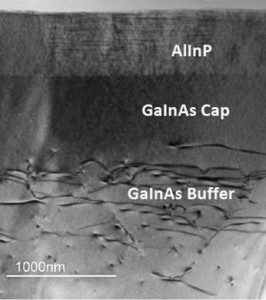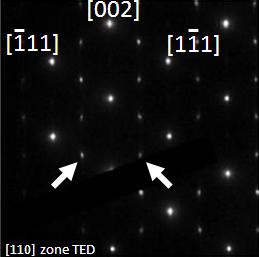Lattice Mismatched Epitaxy of AlGaInP for Yellow-green LEDs
- Category: Materials
- Tags: eugene fitzgerald, kunal mukherjee, leds
Yellow-green LEDs with emission at the wavelengths of 570-580 nm are commercially interesting because they can be combined with blue LEDs (470-480 nm) to create energy efficient white light. More recently there has also been interest in combining yellow-green LEDs with red, green, and blue LEDs to allow for the fabrication of high-quality tunable color LEDs for commercial lighting and displays [1] . Alloys of (AlxGa1-x)0.5In0.5P lattice matched to a GaAs substrate have traditionally been used to make 650-nm red LEDs (x=0) and, by increasing the aluminum/gallium ratio (x=0.4), amber LEDs at 610 nm. The efficiency of this alloy drops sharply with any further increase in aluminum/gallium as the material slowly transitions to having an indirect bandgap [2] .
Growing AlGaInP on lattice engineered substrates, away from the GaAs lattice constant, breaks the lattice matching constraint on composition and allows for greater flexibility in moving from amber to yellow-green emission without severe reduction in efficiency [3] . In this project we start out with a GaAs substrate and grow compositionally graded buffers of either GayIn1-yAs or GazAs1-zP to reach lattice constants greater or lesser than GaAs, respectively. Once the desired lattice constant is reached, AlGaInP lattice matched to the buffer is grown, and its optical properties are characterized. AlGaInP alloys are also known to exhibit CuPt-B ordering under certain growth conditions that affect the bandstructure [4] . There are very limited reports on growing AlGaInP at compositions that are not lattice-matched to GaAs, so this project aims to experimentally map out the bandgap/color space and effect of ordering in this material system as well. LEDs based on lattice mismatched AlGaInP are currently being fabricated to investigate the optical quality of the film as well as the effect of dislocations on device efficiency and lifetime.
- Figure 1: Cross section TEM micrograph of an Al0.35In0.65P film grown on a Ga0.8In0.2As compositionally graded buffer on a GaAs substrate. The lattice mismatch is completely relaxed via misfit dislocations in the buffer away from the AlInP film.
- Figure 2: Electron diffraction pattern along the [110] axis of the Al0.35In0.65P film showing additional superspots (marked by arrows) at the ½[-1 1 1] and ½[1 -1 1] direction typical of CuPt-B ordering. The ordering has been shown to reduce the bandgap by more than 150meV.
- D. A. Steigerwald, J. C. Bhat, D. Collins, R. M. Fletcher, M. O. Holcomb, M. J. Ludowise, P. S. Martin, and S. L. Rudaz, “Illumination with solid state lighting technology,” IEEE Journal of Selected Topics in Quantum Electronics, vol. 8, no. 2, pp. 310–320, Apr. 2002. [↩]
- G. B. Stringfellow, High Brightness Light Emitting Diodes. Academic Press, 1997. [↩]
- M. J. Mori and E. A. Fitzgerald, “Microstructure and luminescent properties of novel InGaP alloys on relaxed GaAsP substrates,” J. Appl. Phys., vol. 105, no. 1, p. 013107, 2009. [↩]
- M. Schubert, B. Rheinländer, E. Franke, I. Pietzonka, J. Škriniarová, and V. Gottschalch, “Direct-gap reduction and valence-band splitting of ordered indirect-gap AlInP2 studied by dark-field spectroscopy,” Phys. Rev. B, vol. 54, no. 24, p. 17616, Dec. 1996. [↩]

